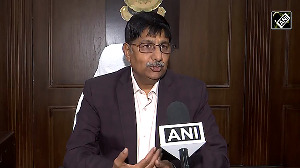But why has the tragi-comic manner in which the hosts have made their exit from the World Cup found so little sympathy from cricket aficionados, and even lesser scrutiny from the pundits who probe every pore?
You might say that a dreadfully boring side that only manages to beat Kenya, Canada and Bangladesh in the game's premier tournament, and excites nobody except themselves with their brand of cricket, doesn't deserve any sympathy.
And you might also say that getting stumped by simple arithmetic is poetic justice for a team that places sets so much store by the laptop instead of common sense, and which is embroiled in all manner of wrangles about quotas and stuff.
You might have a point there, but our point is slightly different.
It's the procedure that was adopted that bugs us. And we are bothered about two points in particular relating to the whole issue: Should the fate of a team/match be decided in such a manner? And, worse, can umpires be so hidebound?
(No, this is not about the Duckworth-Lewis method. So you can safely read on.)
Here are the grim details. Shaun Pollock's side was chasing Sri Lanka's 268 under lights at the Kingsmead in Durban on Monday, March 3. They were well on course when mist began to appear, and then heavy rain began to fall. South Africa's target was suitably altered using the D/L method.
There are two theories about what happened next.
The first is that the South African team management miscalculated the actual target. According to this version, Mark Boucher and Lance Klusener, the batsmen in the middle, were told that they should aim for the par score of 229 for 6 at the end of 45 overs, when they should have actually been aiming for 230.
Muttaiah Muralitharan was bowling the 45th over. As the rain got heavier, and the ball got wetter, six runs were required off the last two balls of Murali's over. Fortunately, Boucher hoicked the penultimate delivery for a six. The scores were level. (Sri Lanka had sneaked through when the hosts failed to hit up the target in 34 overs.)
Thinking the job done, Boucher then gently patted the next ball --- the over's last --- to short midwicket. Boucher played safe because a wicket off the last ball would have again tilted the balance in Sri Lanka's favor because of the D/L method.
But when the umpires called off the match at this juncture, Boucher and Klusener found the Sri Lankans celebrating because the match had been tied and because of the tie, South Africa had been thrown out of the tournament.
End of story? Not quite.
A second version, that the South African coach Eric Simons has articulated, claims that there was no miscalculation. It was simply that the rolling-run target kept changing ball by ball, and no one knew when or indeed if the match would be called off.
"It was a bizarre situation, but it would be wrong to say there was a miscalculation," Simons has been quoted as saying. "If that last ball had not been bowled we would have won, and if another delivery had been allowed and we had scored two from it, we would have been ahead again."
But there is a minor (actually quite major!) aside to the first version. Which is that South African 12th man Nicky Boje was sent into the field to communicate the total to the batsmen. Whether he had the figure 229 on his lips or 230, we do not know. (One version attributed to Pollock mentions 229.)
In any case, it was immaterial what "figure" Boje was carrying, because umpire Steve Bucknor, who was doing duty with India's S Venkataraghavan, sent him back. The rules do not permit the 12th man to come on to the field during the course of an over just to give instructions.
He can only walk in only between overs, and that too only if the batsman wants him to bring him something, like replacement gloves. (A cracked bat is another issue.) If it's only an oral instruction he is carrying, the 12th man can only make his way surreptitiously.
As Barry Richards suggests elsewhere on rediff.com, the batsmen could have claimed that the gloves were wet and asked for replacement gloves and received the instructions under that pretext.
Of course, if Boje had been carrying the wrong figure of 229, of course, the whole debate about the 12th man being denied entry falls flat. But if he had gone into the ground with 230 as the mantra and couldn't convey it, then that's another issue.
Our point is: Even if Boje was carrying the wrong figure, why should the batsmen be denied the right of the right figure?
It is foolish to expect the batsmen to carry the D/L tables with them as they step out to bat. Equally, it is implausible to expect them to remember all the 500 or so numbers on them. If the changing equation is available to television commentators, to television viewers, to team members in the dressing room, on what ground can it be denied to the two people who count the most: The batsmen?
More to the point, hundreds of seats have been removed in stadiums across the world to accommodate the giant screen on which replays are shown. If the umpires can be so stuck up about not allowing the 12th man to bring in instructions during the middle of the over, why cannot the giant screen be used to get the message across to the spectators so that they enjoy the artificial thrills infused by arithmetic?
The manner in which the organizers and M/s Bucknor and Venkataraghavan conducted the proceedings as the rain poured down is remarkable for one other reason.
Thousands of spectators, most of them presumably home-team supporters, who paid hundreds of rand to watch their favorite team in action, were kept in the dark as the unseen hand of M/s Duckworth and Lewis was quietly burying their team's chances.
Surely the spectators were entitled to be informed of the status of the game, through the giant screen?
We might have entered the ICE --- information, communication and entertainment --- age but the ICC is still stuck in the ice one.
Would Mark Boucher have patted down the last delivery from Muralitharan's over, the 45th and eventually the last of the match, so tamely to mid-wicket if he knew that the fate of his team in the tournament depended on that ball? Obviously not. But he did because 229 for 6 was the figures that had been drummed into his impressionable ears. He did not want to lose a wicket, which would have meant a defeat for SA.
Why cannot, for instance, the umpires be carrying the D/L tables? If they find it too cumbersome, and if the target keeps getting changed over and over again as it happened on Monday, why cannot the revised targets be communicated by the TV umpire or the match referee to them? And why cannot the umpires communicate it, in turn, to the batting and fielding sides?
But the more ridiculous thing is what one hears about the manner in which the D/L tables that are given to the captains during the break between innings are designed. According to somebody who knows (Steve Waugh, since you ask) these charts give an over-by-over, ball-by-ball breakdown of what the chasing team needs to do in case rain intervenes as it did two nights ago. But .
This is getting hilarious, some commentators say the South Africans were confused because the D/L printouts give an over-by-over, ball-by-ball estimate of what is needed to "tie" a match!
Tie, not win.
You would have thought that the whole point of a match was one for side to score at least one run more than the other side and that this is exactly the point that needs to come across in a printout. But no -- apparently M/s Duckworth and Lewis only suggest how you should get scores level in case rain intervenes. In a politically correct world, this might go down as ensuring a "level-playing field". But in sport?
The South Africa fiasco demonstrates that you can never fully underestimate the intelligence of a cricketer.
Shaun Pollock may be a studious, intense guy who has his head screwed at the right place on his shoulders, as opposed to, say, Lance Klusener, the Zulu farmer who scurried for an impossible single when one run was required off three balls and ran himself and his team out of the World Cup in 1999.
But should we presume all that by merely looking at Pollock? What is it that prevents the ICC from providing the captains with D/L charts with the scores needed for victory not for a tie, and preferably typed in 24-point letters?
Dr Ali Bacher is too much of an on-air gentleman to reveal the true depth of his feelings for this humongous cock-up that has left the hosts stranded. Spectators and audiences have no problem with South Africa being knocked out for cricketing reasons. But as the Super Six begins, they might well rue the pleasure of Africa's most professional team.





